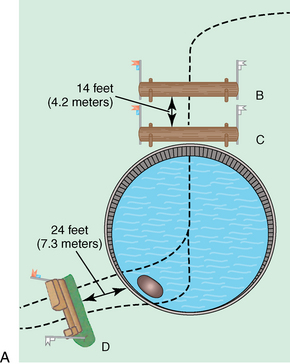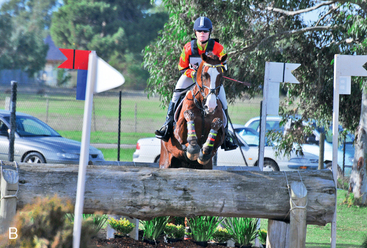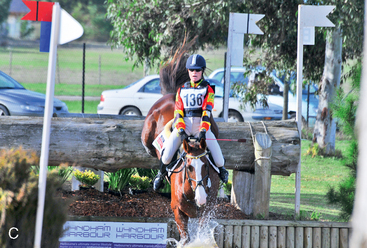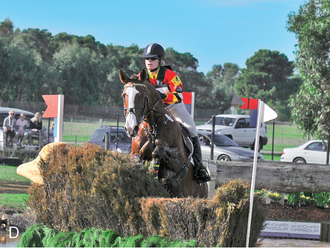CHAPTER 23 The cross-country phase has increased in technical difficulty in recent times (Figure 23-1), as fixed fences are designed to be more natural than the pure jumping fences and are built over variable, mostly undulating terrain. Although the actual sizes of the fences have not increased, the variations of terrains where the fences are placed have been cleverly utilized by course designers to create challenges for the horse-and-rider team. Essentially, course designers are aiming to test a horse’s training and rideability as much as its courage since the jumping effort asked of the horse may be potentially dangerous. The current courses demand absolute accuracy of stride rhythm and line, which would enable the horse to reach the correct take-off point and successfully negotiate the obstacle. Major championships, for example, the 2006 Aachen World Equestrian Games and the 2008 Olympic Games (where the equestrian events were held in Hong Kong), have developed cross-country courses of high technical difficulty combined with a tight course time to provide a discriminatory phase of the competition. The show jumping phase has also become more demanding and influential as the heights and technical difficulty of this phase have increased. Lowering of the height or width of the fence—a “rail down”—results in 4 penalties, as does the first refusal. The second refusal, fall of horse or rider, or a course error constitutes elimination. Time penalties can also become very expensive with each second or part thereof over the optimal time resulting in 1 time penalty. The intense pressure of the show jumping phase, where riders enter the competition arena in reverse order of merit, has caused many riders to plummet down in the final standings or even become distracted and lose their way on course, resulting in elimination. The show jumping is especially important at the Olympic Games, where, since 2004, a second show jumping round has been used to decide the individual medals. Short-format events are one-day events and CIC classes that are generally considered preparatory for the long-format or CCI classes. Long-format (CCI) classes, which maintain a longer cross-country course, are held over 3 to 4 days and can be run with or without Steeplechase. Very few CCI classes have been run with Steeplechase to this author’s knowledge, since the tragedy of a rider fatality at Burghley CCI**** in 2004, where the course was run over maximum length in sticky going that proved very tiring for the horses. This was in direct contrast to the 2004 Athens Olympic Games, where the cross-country was under 10 minutes for the first time. Strong conformation of the event horse is paramount given both the amount of preparatory fitness training necessary to perform successfully in the cross-country phase and the varying ground conditions that they will compete over during their careers (see also Chapter 15). Jump training is then a natural progression from pole work, with the jump being just an elevated canter stride. However, it is best that the young horse begin jumping out of trot so that it can remain balanced and straight on its approach to the fence. Once the horse has been convinced that it is best to go over, not around, these new obstacles in its path, then cantering over small single fences and straightforward related lines can begin. When these exercises are performed consistently with good rhythm, then combinations and more complex lines can be included in the training in preparation for show jumping and preliminary competition days. In conjunction with jumping single fences and lines to simulate those encountered in competition, gymnastic or suppling jump exercises should be introduced to encourage the young horse to fully use its body to jump the fence. These exercises generally involve jumps that are much smaller in size; in effect they are low-impact exercises and so can be performed with higher repetition. Small, narrow corners and relatively wide-faced arrowheads (narrow-faced fences with wings) can also be introduced as part of the young horse’s jump training. These fences are best set up in an arena starting with the use of plastic drums or blocks. It is a sound training principle to train the young horse at a higher level than that which is expected in the competition arena; extra time spent in training should provide the young horse with a solid foundation prior to beginning its competition career.
Training the event horse
The sport of modern eventing
Dressage, cross-country, and show jumping phases
Weighting of phases and scoring system
Short versus long format
Selecting the ideal horse
Training the young horse
Flat and jump training
![]()
Stay updated, free articles. Join our Telegram channel

Full access? Get Clinical Tree






